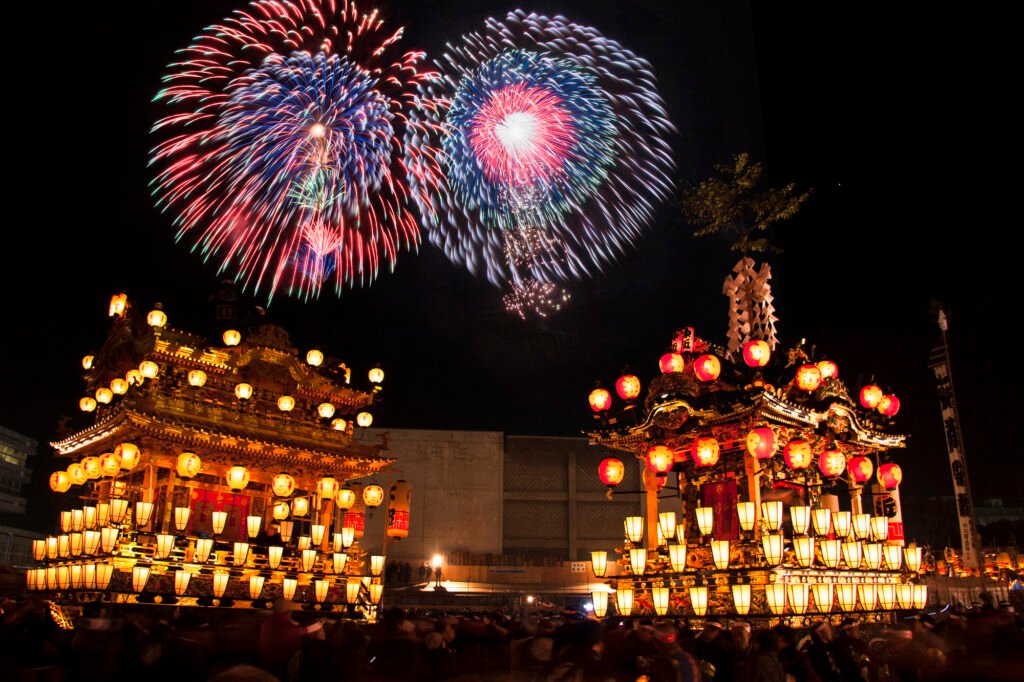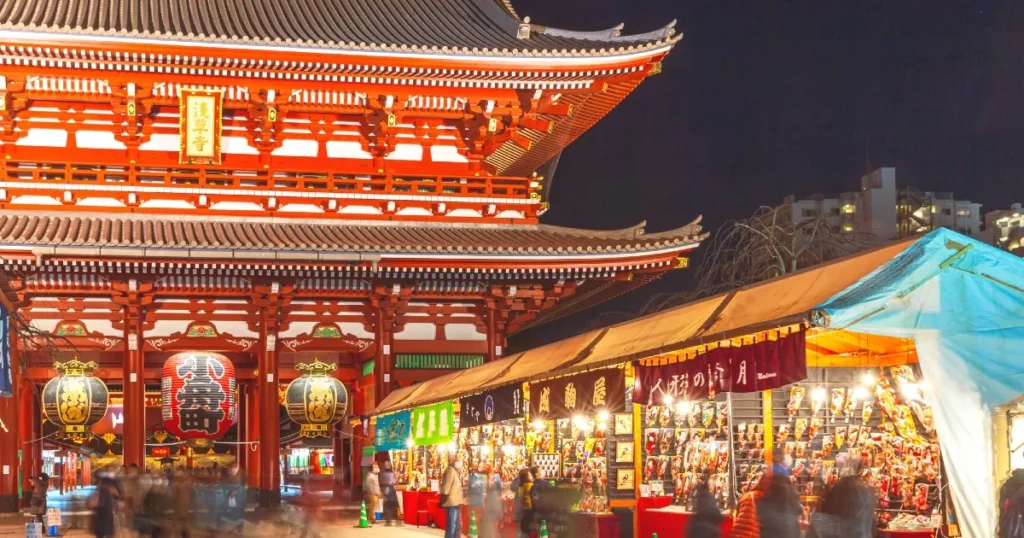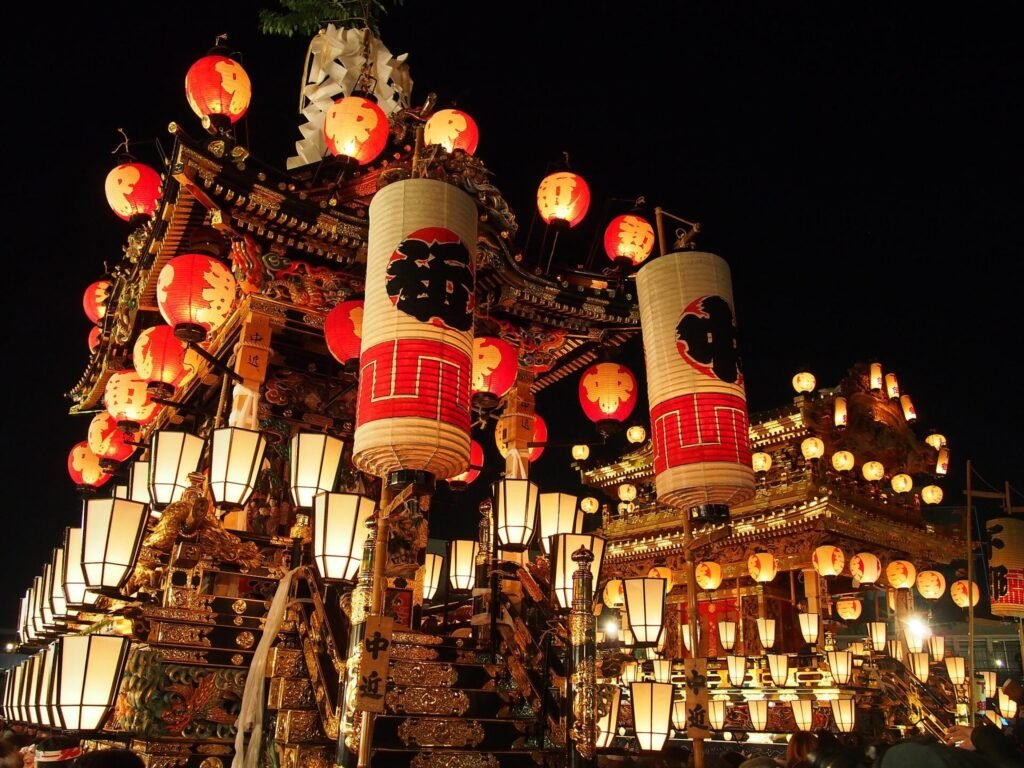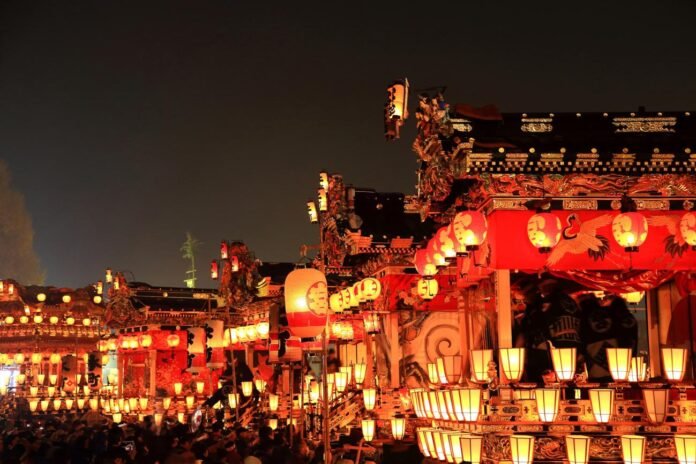In December, Japan comes alive with vibrant festivals and cultural celebrations. From dazzling illuminations to ancient rituals, December festivals in Japan offer a glimpse into the country’s rich traditions and lively spirit.
December in Japan is a time of festive cheer and cultural splendor. It’s when the country showcases some of its most cherished traditions through colorful events and gatherings. Whether you’re mesmerized by the twinkling lights of Kobe Luminarie or intrigued by the ancient rituals of Shimai Kobo, there’s something magical about experiencing these celebrations firsthand.
In this blog post, we’ll dive into the enchanting world of December festivals in Japan. From the iconic Chichibu Yomatsuri to the serene ceremonies of Okera-mairi, each festival offers a unique glimpse into Japanese culture and history. Join us as we explore the highlights, traditions, and charm of these captivating events across the Land of the Rising Sun.
Discovering Chichibu Yomatsuri: A Night of Lights
Chichibu Yomatsuri, held annually on 2-3 December in Saitama Prefecture, is a dazzling spectacle that draws visitors from far and wide. This grand festival is renowned as one of Japan’s three grandest float festivals and is listed as a UNESCO Intangible Cultural Heritage. The highlight of the festival is the procession of lavishly decorated floats adorned with lanterns, creating a mesmerizing display of light and color against the night sky.
The festival atmosphere is vibrant, with locals and tourists alike enjoying traditional festival foods and drinks. From savory yakitori skewers to sweet taiyaki pastries, there’s a culinary delight for every palate. Families gather along the streets to watch fireworks light up the night, adding an extra touch of magic to the festivities.
The Chichibu Yomatsuri is not just a celebration of tradition but also a reflection of community spirit and cultural pride. Each float represents a neighborhood’s craftsmanship and dedication, passed down through generations. It’s a time when old and young come together to celebrate heritage and create memories that last a lifetime.
Kobe Luminarie: Honoring Resilience through Light
Kobe Luminarie, held annually in Kobe City, Hyogo Prefecture, is a breathtaking light-up event with a poignant backstory. First organized in 1995 to commemorate the victims of the Great Hanshin-Awaji Earthquake, this event has grown into one of Japan’s most beloved winter traditions. Visitors are treated to a spectacular display of illuminated arches, creating a tunnel of light that symbolizes hope and renewal.
The atmosphere at Kobe Luminarie is both solemn and celebratory. Families and friends gather to stroll through the illuminated streets, marveling at the intricate light installations. Alongside the visual spectacle, there are performances of music and dance, adding to the festive ambiance. Local food stalls offer a variety of treats, from steaming bowls of ramen to sweet crepes, ensuring that there’s something for everyone to enjoy.
Kobe Luminarie is not just about admiring lights; it’s about coming together as a community to remember the past and look towards the future with optimism. The event’s message of resilience and solidarity resonates deeply with both locals and visitors alike, making it a truly unforgettable experience.

kenoue Misogi Matsuri: Cleansing Ritual in Gifu
The Ikenoue Misogi Matsuri, also known as the Hadaka Matsuri, takes place on 11 December each year at Katsuragake Shrine in Gifu Prefecture. This unique festival centers around a purification ritual where boys and men dressed in loincloths plunge into the icy waters of the Nagara River. The ritual is believed to cleanse participants of impurities and bring good fortune and success in the coming year.
Participants prepare for the ritual with solemn prayers and purification rites performed by shrine priests. As they enter the river, cheered on by spectators, the atmosphere is charged with energy and determination. After the cleansing dip, participants return to the shrine for further prayers and rituals to complete the purification process.
The Ikenoue Misogi Matsuri is more than just a physical challenge; it’s a spiritual journey that connects participants with ancient traditions and beliefs. For visitors, witnessing this sacred ritual offers a glimpse into Japan’s deep spiritual heritage and the enduring significance of purification rites in Japanese culture.
Ako Gishi-sai: Commemorating Samurai Loyalty
Ako Gishi-sai is a festival held annually on 14 December in Ako City, Hyogo Prefecture, to honor the legendary 47 Ronin. These masterless samurai, known as ronin, avenged their master’s death with a daring act of loyalty that has become a symbol of samurai honor and devotion. The festival begins with a solemn procession featuring participants dressed in traditional samurai attire, reenacting key moments from the ronin’s story.
The highlight of Ako Gishi-sai is the parade of the 47 Ronin, a poignant reminder of their unwavering loyalty and sacrifice. Spectators line the streets to witness the procession, which culminates in rituals and ceremonies at various shrines and temples throughout Ako. Traditional performances, including martial arts demonstrations and theatrical reenactments, add to the festival’s cultural richness and historical significance.
Beyond its historical roots, Ako Gishi-sai serves as a reminder of the enduring values of loyalty and honor in Japanese society. For visitors, experiencing this festival offers a profound insight into samurai ethos and the timeless tale of the 47 Ronin, ma
Gishi-sai at Sengakuji: Honoring the 47 Samurai
Gishi-sai is an annual festival held on 14 December at Sengakuji Temple in Tokyo Prefecture, dedicated to the 47 Ronin. These masterless samurai, known for their loyalty and sacrifice, are revered in Japanese history and folklore. The festival begins with a solemn procession of participants dressed as samurai, carrying replicas of the ronin’s banners and weapons.
At Sengakuji, visitors can pay their respects at the gravesite of the 47 Ronin, where offerings of flowers and incense are made. The atmosphere is quiet and reflective, as visitors learn about the ronin’s heroic deeds and the enduring legacy of their loyalty. Traditional ceremonies, including martial arts demonstrations and tea ceremonies, are also part of the festival’s program.
Gishi-sai at Sengakuji is more than a commemoration; it’s a celebration of samurai spirit and the values of loyalty and honor. For locals and tourists alike, attending this festival provides a deep cultural immersion into Japan’s feudal history and the timeless story of the 47 Ronin.
Setagaya Boro Ichi: Tokyo’s Oldest Flea Market
Setagaya Boro Ichi is Tokyo’s oldest flea market, with a history dating back to 1578. Held annually on 15-16 December (and again on 15-16 January), this vibrant market is recognized as one of Tokyo’s Intangible Folk Cultural Properties. Over 700 stalls line the streets, offering a treasure trove of goods ranging from antiques and handmade crafts to delicious street food.
The atmosphere at Setagaya Boro Ichi is bustling and festive, as locals and visitors browse through the stalls in search of unique finds. From vintage kimonos and ceramics to traditional sweets and snacks, there’s something to delight every shopper. The market’s historical significance adds an extra layer of charm, with many vendors proudly showcasing centuries-old traditions.
For attendees, Setagaya Boro Ichi is not just a shopping experience; it’s a cultural journey through Tokyo’s rich heritage. Street performers entertain the crowds, while the aroma of freshly grilled food fills the air. Whether you’re hunting for souvenirs or simply soaking in the lively atmosphere, this market offers a glimpse into Tokyo’s past and present.
Hagoita Ichi: Traditional Paddle Market at Sensoji Temple
Hagoita Ichi is an annual market held from 17-19 December at Sensoji Temple in Tokyo Prefecture. The market is famous for its decorative wooden paddles, known as hagoita, adorned with colorful designs depicting kabuki actors, sumo wrestlers, and popular celebrities. Originally used for a traditional New Year’s game similar to badminton, these paddles are now cherished as decorative art pieces and symbols of good luck.
Visitors to Hagoita Ichi can explore rows of stalls selling a variety of hagoita, each intricately crafted and unique. Alongside the paddles, vendors offer other New Year’s decorations, including ornaments and good luck charms. The market’s lively atmosphere is enhanced by street performers and food stalls serving seasonal treats, creating a festive ambiance for all ages to enjoy.
Attending Hagoita Ichi is not only an opportunity to admire beautiful craftsmanship but also to partake in a centuries-old tradition rooted in Japanese culture. For families, it’s a chance to immerse themselves in the spirit of the New Year and bring home a piece of Japanese heritage that symbolizes prosperity and good fortune for the coming year.
Shimai Kobo: Craft Market at Toji Temple
Shimai Kobo is a craft market held on 21 December at Toji Temple in Kyoto Prefecture. This market marks the final market of the year at the temple and features a variety of stalls selling handmade crafts, second-hand kimono, pottery, and traditional Japanese snacks. Visitors can browse through the stalls, interact with artisans, and purchase unique gifts and souvenirs.
The atmosphere at Shimai Kobo is festive and bustling, with locals and tourists mingling amidst the vibrant displays of craftsmanship. From intricate ceramics to beautifully patterned kimono, there’s something to suit every taste and budget. Many stalls also offer hands-on workshops where visitors can try their hand at traditional Japanese crafts under the guidance of skilled artisans.
For attendees, Shimai Kobo offers more than just shopping; it’s a cultural experience that celebrates Kyoto’s artistic heritage. Street performances and cultural demonstrations add to the lively ambiance, making it a delightful outing for families and art enthusiasts alike. Whether you’re seeking a special souvenir or simply enjoying the sights and sounds, Shimai Kobo pro

Zao Juhyo Festival: Snow Monsters in Yamagata
The Zao Juhyo Festival takes place from 25 December to 28 February at Zao Onsen Ski Resort in Yamagata Prefecture. This festival is renowned for its spectacular display of “Snow Monsters,” locally known as juhyo. These natural formations occur when snow and ice accumulate on trees, creating eerie, frost-covered sculptures that resemble mythical creatures and figures.
During the Zao Juhyo Festival, visitors can marvel at these enchanting snow sculptures illuminated against the winter night sky. The resort organizes guided tours and viewing platforms where guests can get up close to the juhyo formations and capture unforgettable photographs. In addition to the juhyo, the festival features fireworks displays, snow activities, and traditional performances that showcase Yamagata’s cultural heritage.
For visitors, the Zao Juhyo Festival offers a magical winter experience that highlights the beauty of nature in Japan’s snowy landscapes. Whether you’re skiing down powdery slopes or strolling through a forest of snow monsters, this festival promises a unique blend of natural wonder and cultural festivities that are sure to captivate visitors of all ages.
vides a glimpse into Kyoto’s rich cultural tapestry.
Chinka-sai: Fire Festival at Itsukushima Shrine
Chinka-sai is a traditional fire festival held on 31 December at Itsukushima Shrine in Hiroshima Prefecture. This ancient ritual involves lighting a large torch with sacred fire from the shrine and carrying it down to Mikasahama Beach. Participants then use the flame to light their own torches, which they take home as talismans to ward off fire-related disasters in the coming year.
The atmosphere at Chinka-sai is solemn yet festive, as locals and visitors gather to witness the symbolic purification ritual. The flickering torchlight casts a mystical glow over the beach, creating a captivating scene against the backdrop of the night sky. Participants often wear traditional attire and chant prayers for blessings and protection in the new year.
For attendees, Chinka-sai offers a profound cultural experience rooted in Shinto traditions. Beyond its spiritual significance, the festival provides an opportunity to reflect on the past year and embrace hope for the future. Whether you’re observing the ritual from afar or participating in the torch-lighting procession, Chinka-sai embodies the enduring spirit of Japanese heritage and community unity.
Okera-mairi: New Year’s Eve Ritual at Yasaka-jinja Shrine
Okera-mairi is a traditional fire ritual held on 31 December at Yasaka-jinja Shrine in Kyoto Prefecture. During this ancient ceremony, a sacred fire is lit using medicinal herbs to purify and cleanse away negative energies from the past year. Visitors can purchase special bamboo cords called “okera” that are lit from the sacred fire and taken home to ward off misfortune and protect against fire-related disasters in the new year.
The atmosphere at Okera-mairi is serene and contemplative, with locals and tourists alike participating in the ritual to usher in the new year with good fortune. The flickering glow of the sacred fire creates a tranquil ambiance within the shrine grounds, where visitors gather to offer prayers and reflect on their hopes for the coming year.
For attendees, Okera-mairi offers a meaningful way to engage with Japanese spiritual traditions and customs. Beyond its religious significance, the ritual provides a moment of introspection and renewal as individuals seek blessings and purification for themselves and their families. Whether you’re observing the ritual quietly or actively participating in the fire-lighting ceremony, Okera-mairi represents a timeless connection to Japan’s cultural heritage and spiritual beliefs.
Ako Gishi-sai: Commemorating the 47 Ronin in Ako City
Ako Gishi-sai is an annual festival held on 14 December in Ako City, Hyogo Prefecture. This festival pays tribute to the legendary story of the 47 Ronin, also known as masterless samurai, who avenged their fallen lord in feudal Japan. The highlight of the festival is a grand parade featuring participants dressed as the 47 loyal samurai, reenacting their historic march through the streets of Ako.
The atmosphere during Ako Gishi-sai is filled with reverence and historical flair, as locals and visitors gather to honor the bravery and loyalty of the 47 Ronin. Spectators line the parade route, cheering on the procession of samurai clad in traditional armor and carrying banners emblazoned with their lord’s crest. The festival also features theatrical performances and cultural exhibits that delve into the rich history of the samurai and their code of honor.
For attendees, Ako Gishi-sai offers a glimpse into Japan’s feudal past and the enduring legacy of honor and loyalty. Beyond its historical significance, the festival fosters community spirit and pride as residents come together to celebrate their cultural heritage. Whether you’re captivated by the dramatic reenactments or exploring the festival’s exhibitions, Ako Gishi-sai provides a memorable experience that honors the spirit of the samurai and their timeless tale of sacrifice and honor.
Zao Juhyo Festival: Snow Monsters at Zao Onsen Ski Resort
The Zao Juhyo Festival takes place from 25 December to 28 February at Zao Onsen Ski Resort in Yamagata Prefecture. This annual winter event showcases the natural beauty of “Snow Monsters,” known as juhyo in Japanese. These majestic frost-covered trees transform into eerie yet enchanting sculptures due to the heavy snowfall and freezing temperatures unique to the region.
During the Zao Juhyo Festival, visitors can admire the illuminated Snow Monsters under the night sky, creating a magical atmosphere reminiscent of a winter wonderland. The resort organizes light displays and events, allowing guests to experience the Snow Monsters up close through guided tours and observation points strategically placed around the ski slopes.
For attendees, the Zao Juhyo Festival offers a surreal journey into Japan’s winter landscape and natural phenomena. Beyond its visual spectacle, the festival celebrates the beauty of nature and the resilience of the local environment against harsh winter conditions. Whether you’re skiing down slopes surrounded by Snow Monsters or enjoying hot drinks by a cozy fire, Zao Juhyo Festival promises an unforgettable winter experience in Japan.

Conclusion
December in Japan is a time filled with colorful festivals that celebrate traditions, history, and the beauty of the winter season. From the majestic Snow Monsters at Zao Onsen to the solemn rituals of Okera-mairi in Kyoto, each festival offers a unique glimpse into Japanese culture and heritage. These events bring communities together, offering locals and visitors alike a chance to enjoy festive lights, delicious food, and traditional performances.
Whether you’re exploring the ancient rituals of purification or cheering on the reenactment of samurai legends, December festivals in Japan provide unforgettable experiences. They showcase the country’s rich cultural tapestry and spirit of celebration, making it a magical time to visit and immerse yourself in Japan’s vibrant traditions.

